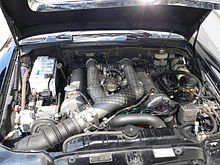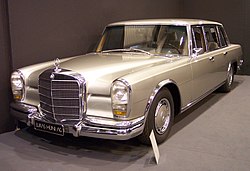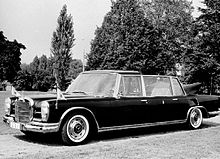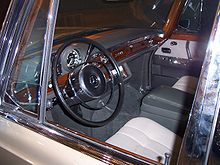Mercedes-Benz W 100
| Mercedes Benz | |
|---|---|
| W 100 | |
| Production period: | 1963-1981 |
| Class : | Upper class |
| Body versions : | Limousine , Pullman limousine , landaulet |
| Engines: |
Otto engine : 6.3 liters (184 kW) |
| Length: | 5540-6240 mm |
| Width: | 1950 mm |
| Height: | 1485 mm |
| Wheelbase : | 3200-3900 mm |
| Empty weight : | 2500-3350 kg |
The Mercedes-Benz 600 , internally referred to as the W 100 , was Daimler-Benz's state and representative vehicle in the 1960s and 1970s .
History and technology
Development history
The origins of the 600 are in the mid-1950s. Fritz Nallinger , leading developer at Daimler-Benz , developed a car that was technically feasible. Among other things, the car received air suspension , automatic transmission , power steering and brakes .

In 1960 the form-finding was completed. Test drives were undertaken with twelve different prototypes, after which the exact specifications of the car were determined.
Presentation in public
The series made its debut in September 1963 at the IAA in Frankfurt. Less than two weeks earlier, the 600 had been introduced to ten specialist journalists from all over the world. The “Big Mercedes” was received very positively by the public. The first orderer, an architect from America, received the first car delivered.
Body styles
There was:
- four-door sedans, almost two meters wide and 5.54 meters long,
- four- or six-door limousines ( Pullman limousines ), 6.24 m long, and
- four- or six-door landaulets , also 6.24 m long.
Two prototypes of a coupe version were produced. One was made available to Fritz Nallinger, the “Nallinger Coupé”, the other was only used for in-house tests. Other unique pieces were a landaulet on a normal, "short" chassis and a landaulet for the Pope.
Of the 2,677 cars, 429 were produced as Pullman or six-door variants and 59 as landaulets; they have a fixed roof over the chauffeur at the front and a convertible top over the passengers at the back. There were two landaulet versions, one with a long and one with a short rear hood. In the Pullman there are two rows of seats arranged opposite each other or folding seats with or against the direction of travel.
custom made
One of the most famous custom-made products is the one for Pope Paul VI. built landaulet . This has four doors, a single armchair at the rear, a 70 mm higher roof and a higher floor in the rear. This unique piece returned to Germany in 1985 after 20 years of service in the Vatican and is on display in the Mercedes-Benz Museum . A landaulet with a shortened wheelbase was built for the Count of Berckheim .
engine

With this luxury sedan, Mercedes-Benz set standards not only in terms of size and weight (between 2.5 and 3.3 tons depending on the version). The M 100 V8 engine with 6.3 liters displacement , manifold injection with eight-piston injection pump and 184 kW was a new development. The top speed of the shorter four-door is 205 km / h, acceleration to 100 km / h takes ten seconds. At that time, the Mercedes-Benz 600 was one of the fastest production vehicles in the world and was also dubbed the “Greatest Sports Car of All Time”. A few years later, the M-100 engine was used in the top model of the W 109 series , the 300 SEL 6.3, and its displacement was increased - again surpassing the now enlarged Rolls-Royce engine - and with Bosch K-Jetronic intake manifold injection provided, also built into the 450 SEL 6.9 . Both sedans were motorized like contemporary sports cars in terms of their performance at the time of their respective appearance.
Technical Equipment
The saloon's equipment included a lot of what was technically possible at the time, and is not a matter of course in today's vehicles even decades later. Examples include: an electrically adjustable heating and ventilation system, air conditioning , a comprehensive hydraulic servo system (so-called "comfort hydraulics") with hydraulically adjustable seats at the front, hydraulically adjustable bench seat at the rear, hydraulic window regulators and also hydraulically operated sliding roofs (the cars with long wheelbase were also available with a sunroof over the rear seats). Compared to electric drives, the hydraulics were almost silent, but quickly lost power when the engine was switched off.
Chassis side, one was air suspension with level control for all wheels noteworthy still Shock regulation manual or automatic, dual-circuit - Servorbremssystem , disc brakes on all wheels, wishbone front and Eingelenk- swing axles at the back. Fifteen patents were registered for the development of the car.
Interior
The equipment options were numerous (choice of veneer, velor or leather, cooling compartment, car phone, sliding roofs in front or in the back).
Facelift
The model update of the 600 was very cautious over the entire production period. Technically, the 600 series has been modernized again and again; Mercedes-Benz refrained from clearly tapering the model during the very long model period. The design of the interior, especially at the front, roughly corresponded to that of the 1965 S-Class W 108 / W 109. When it was replaced by the successor W 116 series in 1972 , the 600 interior looked stale by comparison, but was retained - and rightly so Mercedes-Benz assumed the most conservative of all buyer groups in the 600 buyers.
Only small visible changes were made. In 1969, the previously red colored indicator glasses at the rear had to be changed due to the new StVZO (which came into force on January 1, 1970). It prescribed orange flashing lights. This requirement also had to be met for other vehicles from Daimler-Benz. There were other small changes, for example the cigarette lighter grips were enlarged, or the headrests from the first years of construction called the "slumber roll" were replaced by the headrests of the W 108 / W 109 model series. In the first years of production, rear headrests were standard; at the front they were subject to a surcharge. The exterior mirrors were also replaced by the mirrors from the W 108; the hubcaps now have twelve ventilation slots instead of eight. In 1971 the closing aid for the doors was omitted.
Technical specifications
| engine | V8 gasoline engine Mercedes-Benz M 100 , 6332 cm³, 184 kW |
| transmission | 4-speed automatic |
| length | 5540 mm (6240 mm) |
| width | 1950 mm |
| height | 1485 mm (1500 mm) |
| wheelbase | 3200 mm (3900 mm) |
| Front suspension | Double wishbones |
| Rear suspension | Single-joint pendulum axle with level control |
| Brakes | Front and rear discs |
| Rims / tires | 6.5J × 15 H / 9.00 H 15 Supersport 6 PR |
| Body shapes |
Limousine short and long ( Pullman also with six doors), landaulet |
| Empty weight without driver | 2440 kg (2630 kg) |
| total weight | 2990 kg (3280 kg) |
| Tank capacity | 112 l, of which 19 l reserve |
| Top speed | 205 (200) km / h |
| Fuel consumption | 26.8 l / 100 km |
The information in brackets relates to the seven- or eight-seat 600 Pullman.
Prices
In August 1964 the list price for a 600 Mercedes-Benz was 56,500 marks (adjusted for inflation, based on today's purchasing power, 118,493 euros).
Towards the end of its construction period, according to the price list of February 1, 1979, the car cost:
- 600 sedan, five / six seats, four doors: 144,032 DM (corresponds to 166,936 euros)
- 600 long Pullman, seven / eight seats; four doors: 165,424 DM (191,730 euros)
- 600 long, seven / eight seats, six doors: 175,392 DM (203,283 euros)
- For comparison: the 450 SEL 6.9, the most expensive model of the S-Class at the time, cost 78,960 DM (91,516 euros)
meaning
The production of the 600 series is said to have always been a loss-making business for Mercedes-Benz over the years due to special customer requests and the continuous manual work, despite high prices, which was carried out for reasons of prestige. In addition, the competition to Rolls-Royce and Bentley played a not insignificant role; Rolls-Royce enlarged its own engine from 6.2 to 6.75 liters in order to outperform the 600 with its 6.3 liters. Mercedes-Benz then increased the displacement of the M100 engine from 6.3 liters, as installed in the 600 and 300 SEL 6.3, to 6.9 liters, as used in the 450 SEL 6.9.

The 600 did not even reach ten percent of the targeted annual production of 3,000 units. This made it a very rare car, while Rolls-Royce and Bentley - at that time still two brands from an economically independent manufacturer - sold around 3,000 cars a year.
The 600 series made no direct positive contribution to the economic results of Daimler-Benz. On the other hand, the pictures of state guests of the federal government, which were seen again and again in the (at that time almost unrivaled) news program Tagesschau of ARD, who were driven in the open 600 mm landaulet, shaped the opinion of generations about what a state limousine should look like. The 600 was essential for the reputation of Mercedes-Benz.
owner
Many countries had a 600 in their fleet, including Egypt , Algeria , Ghana , Jordan , Cambodia , Cuba , Austria and Turkey . In Germany, the vehicles were made available to the federal government and the Federal President of Daimler-Benz from their vehicle fleet.
The following people were among the prominent owners of a Mercedes-Benz 600:
- Elizabeth Taylor
- Manuela (The Berlin pop singer owned a red 600 and drove it to the stage of her shows in the Dunes Hotel in Las Vegas.)
- John Lennon (later sold to fellow Beatles fellow George Harrison )
- Rudolf shock
- Ivan Rebroff
- Udo Juergens
- Elvis Presley
- Herbert von Karajan
- Aristotle Onassis
- Coco Chanel (later sold to Jay Kay )
- Gunter Sachs
- Max Grundig
- Shah Mohammad Reza Pahlavi
- Johannes von Thurn and Taxis
- Leonid Brezhnev (The 600 series, built in 1966 and driven privately by him during his tenure as General Secretary of the Central Committee of the CPSU , came into the possession of an anonymous bidder in 2008 by foreclosure by the Potsdam Tax Office for 103,600 euros.)
- Emperor Hirohito
- Les Humphries
- Kim Il-sung
- Gustav Schickedanz
- Jay Leno (a vehicle retrofitted with a compressor)
- Jeremy Clarkson
- Pablo Escobar
- Reinhard Mey
- David Bowie
- Florian Schneider (- Esleben) (in: Rüdiger_Esch, ELECTRI_CITY Electronic_Musik from Düsseldorf, Suhrkamp 2014, pp. 140f.)
Trivia
The 600 can be seen in a scene from James Bond 007 - On Her Majesty's Secret Service from 1969, when the assistant to the villain Ernst Stavro Blofeld ( Telly Savalas ) from the back of a 600 , Teresa ( Diana ), who was newly married to James Bond ( George Lazenby ) Rigg ). The W 100 also appears in the following film, Diamond Fever , as well as in Octopussy , in which Prince Kamal Khan ( Louis Jourdan ) gets into a 600 after an auction.
literature
- Heribert Hofner: Mercedes-Benz 600. Delius Klasing, Bielefeld 2001, ISBN 3-7688-1199-9 .
- Michael Wiedmaier: Mercedes-Benz 600 - The fine way of driving. WKF-Verlag, Freilassing 2008, ISBN 3-9807271-4-9 .
Web links
Individual evidence
- ↑ Development trends in European passenger cars. In: Motor Vehicle Technology 9/1964, pp. 342–344.
- ↑ a b c d e f g h Archived copy ( memento of the original dated December 27, 2010 in the Internet Archive ) Info: The archive link was inserted automatically and has not yet been checked. Please check the original and archive link according to the instructions and then remove this notice.
- ↑ a b c d e f g h i j http://classic-oldtimers.de/ ( Memento from February 10, 2013 in the web archive archive.today )
- ↑ Jay Leno's Garage - 1972 Mercedes-Benz 600 Supercharger
- ↑ Inside Cocaine Kingpin Pablo Escobar's Amazing Car Collection. Retrieved November 1, 2018 .
- ↑ Tobias Wiethoff: Take us with you, captain . May 28, 2005 ( welt.de [accessed October 17, 2019]).
- ^ Rob Hughes: David Bowie remembers Berlin . January 6, 2017 ( uncut.co.uk ).
| Vehicle class | 1920s | 1930s | 1940s | ||||||||||||||||
| 6th | 7th | 8th | 9 | 0 | 1 | 2 | 3 | 4th | 5 | 6th | 7th | 8th | 9 | 0 | 1 | 2 | 3 | 4th | |
| Compact class | W 15 (type 170) | ||||||||||||||||||
| W 23 (type 130) | |||||||||||||||||||
| W 30 (type 150) | |||||||||||||||||||
| W 28 (type 170 H) | |||||||||||||||||||
| Middle class | W 02 (type Stuttgart 200) | W 136 / W 149 (types 170 V / 200 V) | |||||||||||||||||
| W 11 (type Stuttgart 260) | W 143 (type 230 n) | ||||||||||||||||||
| W 21 (type 200/230) | W 153 (type 230) | ||||||||||||||||||
| W 138 (type 260 D) | |||||||||||||||||||
| upper middle class | W 03 / W 04 / W 05 (types 300/320/350) | W 18 (type 290) | |||||||||||||||||
| W 10 / W 19 (types 350/370/380) | W 142 (type 320) | ||||||||||||||||||
| W 22 | |||||||||||||||||||
| Upper class | Type 400 & Type 630 | W 24 / W 29 / W 129 (types 500 K / 540 K / 580 K) | |||||||||||||||||
| W 08 (type Nürburg 460/460 K / 500 / type 500 N) | |||||||||||||||||||
| W 07 / W 150 (types 770/770 K) | |||||||||||||||||||
| Sports car | Model K | ||||||||||||||||||
| W 06 (type S / SS / SSK / SSKL) | W 24 / W 29 / W 129 | ||||||||||||||||||
| Off-road vehicle | W 103 (type G1) | W 31 (type G4) | |||||||||||||||||
| W 133 III (type 170 VG) / W 139 (type 170 VL) / W 152 (type G5) | |||||||||||||||||||
| Vans | L 3/4 | L 1000 Express | L 301 | ||||||||||||||||
| L 300 | |||||||||||||||||||




